- Home
- Missions
- Data
- Communications
- People
- The Earth Observer Newsletter
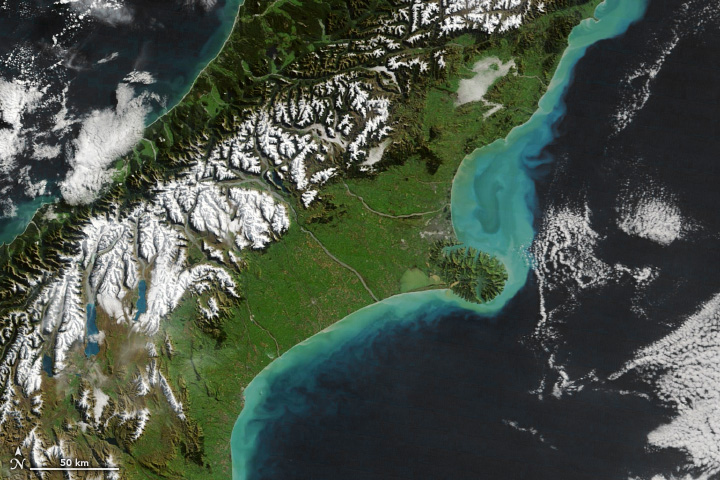
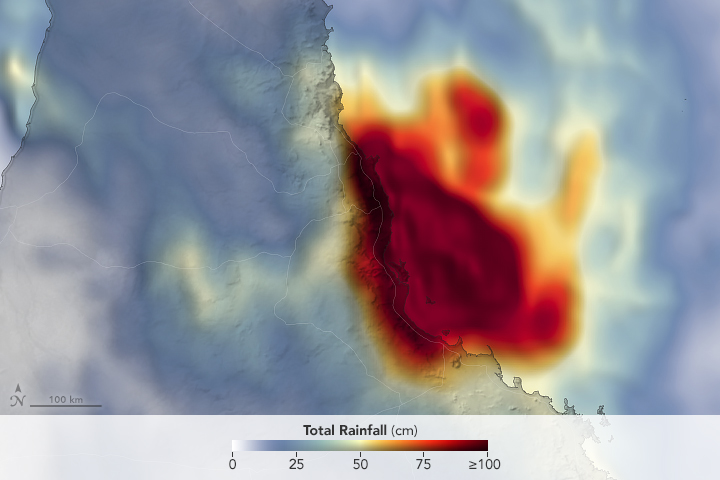
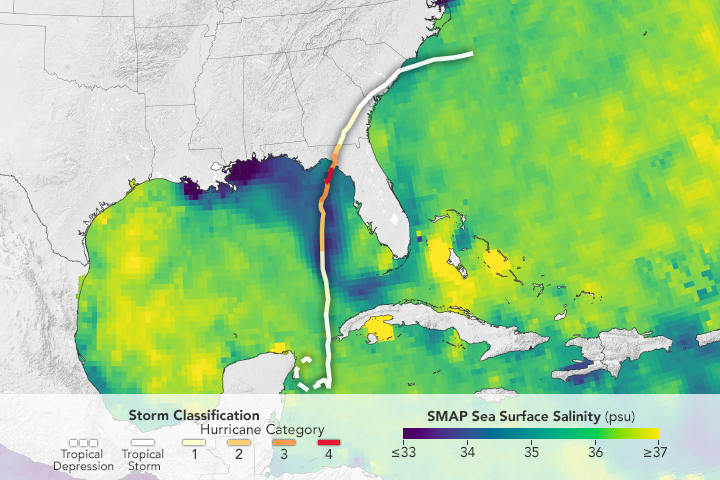
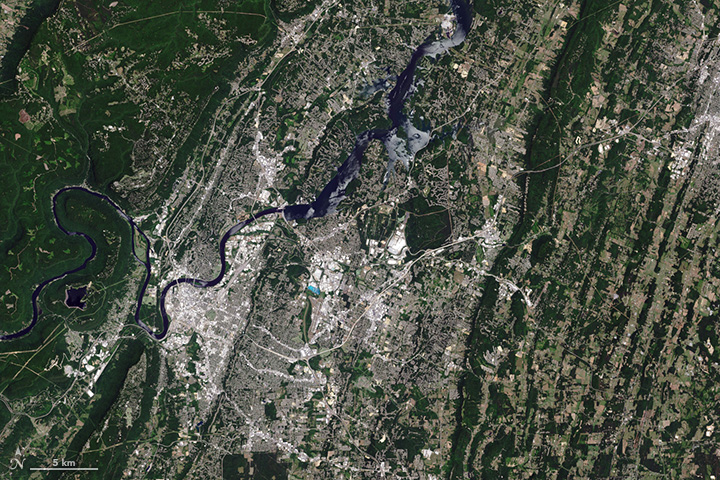
Recent Imagery
You will be directed to the NASA Visible Earth webpage when you select Images by Mission below, or click on the images at right that are randomly generated to represent four out of all possible topics.
Featured Content
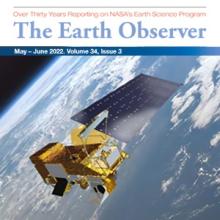 |
Aqua Turns 20On May 4, 2002, at 2:55 AM Pacific Time, a rocket carrying NASA’s Aqua satellite—the second flagship satellite of the agency’s Earth Observing System (EOS) launched into space from Vandenberg Air Force Base, located in California. Since then, Aqua has orbited the Earth more than 100,000 times, and produced one of the longest near-continuous records of Earth observation data ever assembled. Its momentous Earth observation voyage has continued for more than two decades—far beyond anyone’s expectations. |
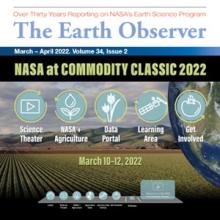 |
NASA Earth Science Data: A Valuable New Commodity for America’s FarmersNASA recently participated in the Commodity Classic event in New Orleans, LA. This was NASA’s first time participating in this event, which is one of the largest agricultural trade shows in the U.S.—“created for farmers, by farmers.” NASA had a large presence in the exhibit hall and also offered a virtual participation option. NASA Administrator Sen. Bill Nelson and Brad Doorn [NASA Headquarters (HQ)—Director of NASA’s Water Resources and Agricultural Program] both recorded welcoming remarks for the event. Karen St. Germain [NASA HQ—Director of NASA’s Earth Science Division] attended the event and spoke at the NASA Hyperwall in the exhibit area. Turn to page 4 of the March-April issue of The Earth Observer to read a summary of NASA’s participation in the hybrid Commodity Classic event. |
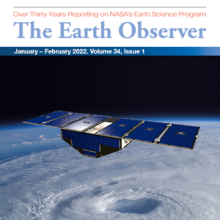 |
CYGNSS: Five Years and CountingThe CYGNSS mission celebrated the fifth anniversary in orbit on December 15, 2021. The longevity of the mission—which was designed to last 24 months—has allowed for a major expansion of the scientific scope of the mission beyond its original focus on the measurement of hurricane winds. New areas of investigation include tropical and extratropical convective systems over ocean, soil moisture and freeze/ thaw state over land, and the mapping of inland water bodies in dynamic seasonal wetlands and due to flood inundation. Turn to page 5 of the Jan-Feb issue of The Earth Observer to learn more about the scientific and engineering achievements of this remarkable constellation of eight microsatellites after five years in orbit. |
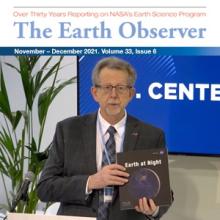 |
The Earth Observer Features IMPACT and COP26The Nov-Dec 2021 issue of The Earth Observer features an article that describes NASA’s Interagency Implementation and Advanced Concepts Team (IMPACT), which seeks to prototype concepts for optimizing the use of Earth science data. This is an interdisciplinary team within NASA’s Earth Science Data Systems division that will work to maximize the effectiveness and efficiency of Earth science data management and stewardship. Turn to page 4 to learn more about IMPACT. Turn to page 10 of this issue to read about NASA’s involvement in the COP26 meeting held in Glasgow, Scotland. NASA participated in the U.S. Center (organized by the U.S. Department of State), where the NASA scientists used the Hyperwall to share the science. |
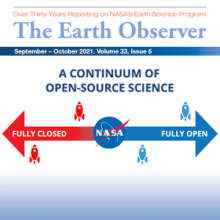 |
Open-Source Science: The NASA Earth Science PerspectiveAn important role that NASA undertakes is to provide data to foster scientific research. For NASA’s Science Mission Directorate (SMD) and Earth Science Data Systems (ESDS) Program, this means anywhere in the world is allowed access to more than 57 petabytes (PB) of NASA Earth observing data—along with all documentation, code, algorithm theoretical basis documents (ATBDs), and other ancillary materials. The feature article in September-October issue of The Earth Observer newsletter describes an evolving NASA paradigm called open-source science, which is taking previous open science efforts to the next level and making research conducted using NASA data—and scientific research in general—more inclusive, collaborative, diverse, and equitable. |
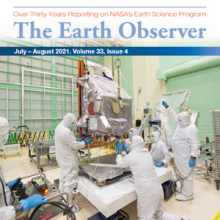 |
The Legacy Continues: Landsat 9 Moves Landsat Toward a Golden MilestoneThe July-August 2021 issue of The Earth Observer features an article on Landsat 9, which is scheduled to launch on September 16, 2021, from Vandenberg Space Force Base in California onboard a United Launch Alliance Atlas V 401 rocket. The spacecraft will be inserted into a 705 km near-polar orbit where it will join the Landsat 8 satellite, essentially taking over the position Landsat 7 now occupies in the Morning Constellation. The launch of Landsat 9 will add a new and exciting chapter to the nearly 50-year story of Landsat observations. |
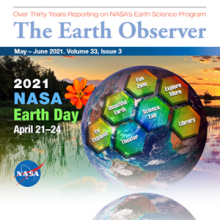 |
Connected by Earth: Summary of NASA’s 2021 Virtual Earth Day EventNASA’s 2021 Virtual Earth Day Event was a successful online event. With registration free and open to the public, NASA was able to celebrate Earth Day with more than 7000 registered attendees around the globe. To read about the live webinar events and other activities, turn to page 4 of the May-June 2021 issue of The Earth Observer. |
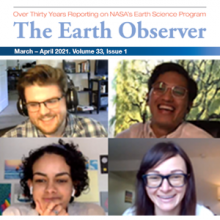 |
NASA’s DEVELOP Program Engages Summer Participants in Virtual ActivitiesDuring DEVELOP’s Spring 2020 term, rapidly evolving circumstances required an ad hoc rollout of a virtual approach to complete the ongoing projects. Participants were roughly seven weeks into the project term in mid-March when the program’s host locations began closing because of the COVID-19 pandemic. In response to these new workplace realities, the DEVELOP Program pivoted from colocating students, emerging professionals, and science advisors at in-person locations to forming virtual teams from across the U.S. Turn to page 4 of the March-April 2021 issue of The Earth Observer to learn more about the DEVELOP Summer 2020 virtual learning experience. |
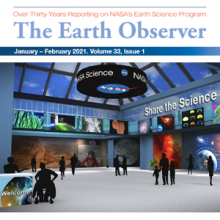 |
NASA Science at the First Virtual AGU Fall MeetingIt is now a familiar routine for NASA’s Science Support Office to end the year coordinating the NASA Science exhibit at the AGU Fall Meeting, held in December each year. But 2020 had different plans in store for everyone, bringing a screeching halt to in-person scientific conferences and events, and hurling the NASA Science exhibit team into new territory: virtual events. The first-ever 100% virtual AGU Fall Meeting, with the tagline Online Everywhere, took place December 1–17, 2020. In an effort to extend the reach of this event, an article in the November-December 2021 issue of The Earth Observer provides screenshots and associated links that visually represent the NASA Science exhibit at the first virtual AGU Fall Meeting. |
 |
Flying in the “Gap” Between Earth and Space: NASA’s Airborne Science ProgramThe feature article in the September-October issue of The Earth Observer focuses on the NASA ESD’s Airborne Science Program (ASP), which is a critical component of the division effort—flying in the “gap” between satellite and ground-based observations. Airborne Earth science goes back to the 1960s, when NASA retrofitted passenger and military aircraft with equipment that enabled collecting in situ and remote sensing data for the full range of Earth science disciplines. In addition to acquiring unique datasets, aircraft campaigns play a major role in supporting satellite missions through calibration (i.e., measurements) and validation (i.e., retrieved geophysical products) activities as well as providing a testbed for future satellite remote sensing instruments. Please turn to page 4 of this issue to read a comprehensive report on the ASP. |
